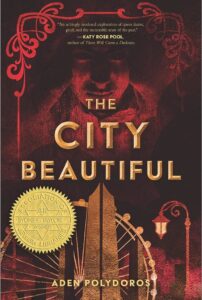The City Beautiful by Aden Polydoros
Inkyard Press, 2021
ISBN-13: 978-1335402509
Available: Hardcover, paperback, Kindle edition, audiobook
Buy; Bookshop.org | Amazon.com
Wow. Polydoros set out to write a work of historical fantasy about Jews and Judaism not set during the Holocaust, and was inspired by an article about H.H. Holmes to set his story among Jewish immigrants from Eastern Europe during the 1893 Chicago World’s Fair.
Alter, the main character, was ill as a baby and named to avoid the notice of the Angel of Death, but people around him frequently die. Alter is also gay, but in denial and ashamed. He is in love with his roommate Yakov, who leaves to meet someone and is found drowned the next day, the most recent of several Jewish boys who are dead or missing.
Alter, a member of the burial society, is helping immerse Yakov in the mikveh when he thinks he sees Yakov move, and jumps in the mikveh to pull the body out. Instead, he is possessed by Yakov’s dybbuk (a dybbuk is a malicious spirit, usually the dislocated soul of a dead person with unfinished business). Alter’s only choices to save his own soul are either0 to exorcise the dybbuk or to find Yakov’s killer and exact revenge. Luckily, he has the help of Raizel, a unionist working for an anarchist newspaper (the local matchmaker keeps trying to hook them up), and Frankie, an ambitious Russian Jewish teenage criminal and boxer who heads a gang of thieves.
This is such a layered, detailed story, both in the integration of the various aspects of Jewish culture and the Eastern European immigrant experience, and the vividness of the Chicago and World’s Fair setting. In addition, it really reveals the viciousness of antisemitism in this country and how it also traveled from overseas. I think people don’t really think about how insidious and common it was. It’s truly a Jewish horror story, and there aren’t too many of those around. I’m so impressed with the research and writing on some very difficult-to-address topics.
The City Beautiful won the 2022 Sydney Taylor Award and was a finalist for the 2022 World Fantasy Award for Best Novel, the 2021 Lambda Literary Award, the 2021 National Jewish Book Award, and the preliminary ballot for the Bram Stoker Award for Toung Adult Novels. The attention is well-deserved.
Reviewed by Kirsten Kowalewski






Follow Us!